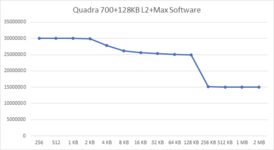eharmon
Well-known member
I've long wondered, why doesn't a ROM-in-RAM utility for the Quadras exist? It was common for 030 and 040 accelerators, and the 68k AV machines had it natively (enabled with a PRAM switch, which AV Turbo ROM can flip for you). (I know you're thinking -- is it because performance changes are minimal? Maybe!)
But I think the answer is one does, but the information has been lost to the sands of time. Enter DayStar QuadraBoost: https://macintoshgarden.org/apps/quadraboost
The readme is vague, the internet information non-existant, and there's a strong implication that it requires a cache card...
...but I had a hunch about what it did, and after cracking open the resources, throwing it on my Q800 board, and looking at memory allocations, I feel pretty strongly that QuadraBoost is actually a ROM-in-RAM utility for 1MiB Quadra ROMs requiring no additional hardware.
It offers three settings, which copy and remap various amounts of the ROM into RAM controlled by a page map in its resources. The most aggressive setting copies over 99% of the ROM to RAM, if I'm reading things correctly.
Is it actually faster in practice? I'm not sure. Quadras have pretty fast ROM access speeds. But 60ns interleaved memory is pretty quick, when you get up to the Quadra 800. Maybe with the boosted cache sizes from a PDS cache card it helps even more, but I don't have one to test with.
Unfortunately, benchmark utilities seem really lacking in this department, concentrating on raw CPU and memory speeds and not the speed of the underlying OS. And newer OS patch and replace ROM functionality anyway, meaning running later operating systems may provide similar benefits. So I'm gonna stick with "maybe". Curious if anyone has any deeper insights.
Note that at least on my system, I was unable to boot with maximum performance set on System 7.1.1, however 7.6.1 and 8.1 worked with no issues.
But I think the answer is one does, but the information has been lost to the sands of time. Enter DayStar QuadraBoost: https://macintoshgarden.org/apps/quadraboost
The readme is vague, the internet information non-existant, and there's a strong implication that it requires a cache card...
...but I had a hunch about what it did, and after cracking open the resources, throwing it on my Q800 board, and looking at memory allocations, I feel pretty strongly that QuadraBoost is actually a ROM-in-RAM utility for 1MiB Quadra ROMs requiring no additional hardware.
It offers three settings, which copy and remap various amounts of the ROM into RAM controlled by a page map in its resources. The most aggressive setting copies over 99% of the ROM to RAM, if I'm reading things correctly.
Is it actually faster in practice? I'm not sure. Quadras have pretty fast ROM access speeds. But 60ns interleaved memory is pretty quick, when you get up to the Quadra 800. Maybe with the boosted cache sizes from a PDS cache card it helps even more, but I don't have one to test with.
Unfortunately, benchmark utilities seem really lacking in this department, concentrating on raw CPU and memory speeds and not the speed of the underlying OS. And newer OS patch and replace ROM functionality anyway, meaning running later operating systems may provide similar benefits. So I'm gonna stick with "maybe". Curious if anyone has any deeper insights.
Note that at least on my system, I was unable to boot with maximum performance set on System 7.1.1, however 7.6.1 and 8.1 worked with no issues.


